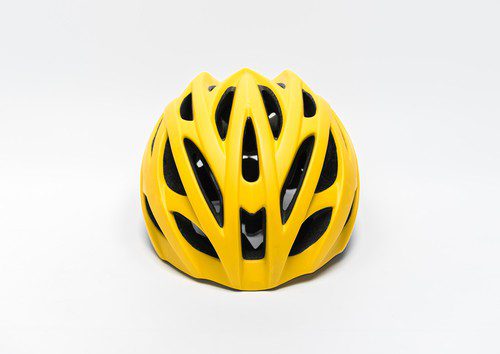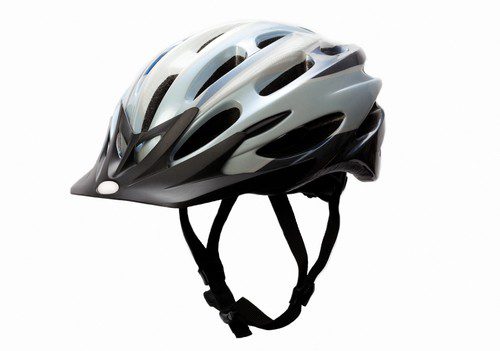Helmet manufacturers design helmets differently based on their intended use. With that said, skate helmets and cycling helmets are quite different. The level of protection differs for each, so it’s crucial that consumers know how to choose the correct helmet to protect themselves from severe head injuries.
You can safely use skate helmets for cycling if the helmet is CPSC certified. Non-compliant skate helmets, however, should not be used by cyclists. These helmets do not provide adequate protection against high-force impact.
There are many differences between skate helmets and cycling helmets, and many of these variations are visible—vents, visors, shapes, and style—whereas others are internal. The internal components play a more vital role in protection. Read on to learn whether you can safely use skate helmets for cycling.
Helmets Need Impact Protection
Helmet manufacturers design their products based on their intended purpose; therefore, bike helmets and skating helmets are not the same in terms of impact protection.
Skate helmets provide protection against multiple, minor impacts, such as those that you’d see during skating or skateboarding. They do not protect against strong-force or high-speed impacts, such as car collisions.
In contrast, bicycle helmets protect against extreme impacts, including high-speed collisions.
These helmets are so strong, in fact, that they reduce severe traumatic brain injury by 51 percent. The hard, plastic outer shell is smooth, which allows it to slide across surfaces without injuring the neck.
Although manufacturers design cycling helmets to withstand a single, hard impact, they can also support minor hits without the need for replacement.
A cyclist running into a small tree branch, for example, isn’t going to do much damage and would not require the rider to seek out a replacement helmet. If there is visible damage, however, you’ll need to purchase a replacement.
Based on impact protection alone, it is not recommended that cyclists use a skate helmet during bike rides unless the helmet conforms to the federal Consumer Product Safety Commission (CPSC) standards. If the helmet is non-compliant, it will not provide adequate protection against strong impacts, which are far more likely when riding a bike.
The Helmets Need Different Types of Foam
Manufacturers use foam in helmets for energy management and shock absorption. On impact, the foam cushions the blow to the head, allowing the helmet to absorb most of that kinetic energy.
The level of impact protection depends on the type of foam used in the helmet.
There are two types of foam used in protective headwear for skate and bike helmets. Some protect against single, hard impacts, whereas others provide protection against softer impacts.
- Expanded Polypropylene (EPP) is a soft, light, squishy foam that protects the head. After a minor impact, the foam restores itself back to its original shape, thanks to its rubber-like qualities. EPP is most often seen in skating helmets.
- Expanded Polystyrene (EPS), however, is a firm, rigid foam that can withstand a heavy load. Once the foam experiences an intense, high-force impact, the foam breaks, so cyclists must replace the helmet post-accident. The foam is available in several different strengths.
Over the years, there has been quite a bit of debate about which type of foam is safest for cyclists. Many argue that EPP is adequate because it protects from multiple, minor impacts. In general, it sounds like a good idea. After all, bicyclists sometimes sustain minor falls.
The problem, however, is that you cannot see the damage left behind. That means bicyclists are left to guess whether or not the helmet is capable of withstanding another impact.
The guessing game does not provide peace of mind and is precisely why most cyclists prefer EPS over EPP.
Skating and Cycling Helmets Have Different Areas of Protection
In addition to different levels of protection, skate and cycling helmets offer protection for different areas of the head.
- Road Bike Helmets: These helmets protect the top of the head and usually leave the lower back of the head exposed because it is incredibly uncommon for bicyclists to fall backward off of their bike. Because of forward momentum, bikers are far more likely to fall forward.
- Mountain and BMX Bike Helmets: These Mountain and BMX bike helmets protect the top and back of the head. For extreme sports, the helmet may include a visor and face protection. Jumping on a bike or moving on rough terrain at high speeds naturally requires more protection. Because there are many ways in which these bicyclists move, falls can happen in any direction.
- Skate Helmets: These Helmets for skaters protect the top, lower part, and back of the head. Skaters are far more likely to fall backward versus cyclists. Electric skateboards, in particular, put the rider at a greater risk of falling backward, thanks to quick acceleration. If a rider misjudges the throttle, they could easily be thrown back off of the board.
Both Sports Have Safety Standards and Certification Protocols
Different sports have different helmet safety standards. Some standards are just general rules that manufacturers follow for safety benefits, whereas others are more strict, government-mandated standards.
By law, a helmet made explicitly for bicycling must meet the CPSC standard in order to be sold in the United States market.
You can determine if a helmet conforms to safety standards by purchasing only CPSC helmets and checking the helmet upon purchase. These helmets have stickers that indicate efficacy and ensure that the product meets safety standards, which guarantees that manufacturers have tested the helmet and approved it for its intended use.
On the other hand, skate helmets are not always certified, and by law, they do not have to be. These helmets provide some level of protection, but that protection is not guaranteed.
Some higher-end helmets, however, feature an American Society for Testing and Materials (ASTM) certification. This certification ensures that the helmet can withstand multiple impacts. The safest models of skate helmets include dual-certifications, meeting both CPSC and ASTM standards, which are suitable for use by cyclists.
Functionality Of Skating vs. Cycling Helmets
In addition to safety features, helmets have some aesthetic and functional differences as well. These differences might include the inclusion or exclusion of vents and visors.
Vents for Cooling

Manufacturers add vents to helmets to aid in cooling. Cycling helmets tend to have more vents than skate helmets.
Road bike helmets contain the most vents because they cycle more and are typically exposed to the sun. The head heats up constantly, so vents provide extra airflow for cooling.
Some road cyclists, however, prefer little to no vents, especially if they’re into aerodynamics.
Mountain bikers spend most of their time in the shade and therefore do not have much use for air vents compared to road cyclists.
Skate helmets have a limited number of vents.
Visors To Protect the Face From Branches

Helmet manufacturers sometimes include visors to protect the rider’s eyes from the sun.
Visors are seen more often on mountain and BMX bike helmets. They protect the rider against low-hanging branches. They may not seem like much of a threat at low speeds, but at high speeds, these branches can “whip” the rider in the face, causing them to lose balance.
Road cyclists do not typically require visors on their helmets, as they tend to wear sunglasses. They also ride with their heads low, and wearing a visor in this position could obstruct their vision.
Skate helmets do not usually contain visors. There are some skate helmet brands, however, that provide consumers with the option to purchase skate helmets with small visors.
One Helmet for Skating and Cycling
If you’re looking for a skate helmet that’s safe for cycling and skating, choose one that is dual-certified.
Helmets with CPSC and ASTM certifications are safe for both activities. I recommend the Triple Eight Dual-Certified Bike and Skateboard Helmet from Amazon. This helmet comes in six different styles and three size options and it uses an ABS shell and EPS foam.
As discussed earlier, bicycle helmets sold in the United States must meet CPSC standards.
The certification guarantees that the helmet has been tested and will protect against severe skull and brain injuries. ASTM certification ensures that the helmet’s design is safe for skaters and offers adequate protection during skateboarding, in-line skating, and during tricks.
One of the significant benefits of having a dual-certified helmet is that it allows you to switch between activities without changing helmets. In addition, using only one helmet is more cost-effective than having to purchase one for each activity.
If you’re using a dual-certified helmet for multiple activities, always check the helmet for damage in between uses. Helmets for cycling should be replaced after one accident that causes extreme force.
For minor dings and small-force impacts, the helmet should be fine.
Final Thoughts
Non-compliant skate helmets and CPSC-compliant skate helmets provide significantly different levels of protection. If a cyclist has a choice between the two, they should pick the CPSC-certified version every time.
There’s a reason that the CPSC holds cycling helmet manufacturers to a specific standard.
During a bike ride, cyclists are exposed to fall and collision risks at greater speeds than skateboarders or skaters. These standards ensure that the cyclist’s skull and brain are protected in the case of a catastrophic fall or accident. Therefore, riders should invest in CPSC helmets.
Related Articles:
This is Why Road Bike Helmets Don’t Need Visors
The Bike Laws on Bike Lights: What You Need and When

